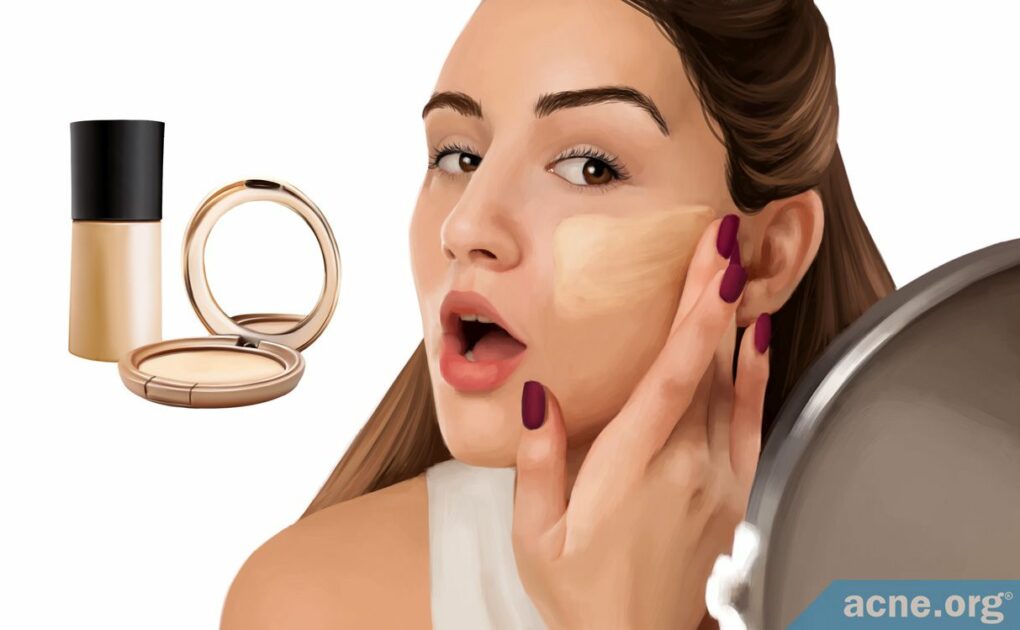Choose a Foundation That Is Free of Pore-clogging Ingredients and Apply It Very Gently

The Essential Info
Because foundation covers acne-prone areas of the face, choosing the right foundation for acne-prone skin requires particular care. Before buying any foundation, always check the list of ingredients. Avoid foundations that contain pore-clogging ingredients. Select a fragrance-free foundation, as fragrances may irritate the skin and worsen acne, or may cause allergies in some people. If possible, opt for a foundation with broad-spectrum sunscreen. A foundation containing salicylic acid may be preferable, if you can find one.
Be gentle when applying foundation to avoid irritating the skin.

The Science
- Guidelines for Choosing a Foundation for Acne-prone Skin
- List of Common Comedogenic (Pore-clogging) Ingredients in Makeup
- Tips for Using Foundation on Acne-prone Skin
Foundation is a makeup product used to:
- Reduce the appearance of acne
- Even the skin tone
- Cover minor skin imperfections like enlarged pores, dark spots, and small wrinkles
- Create the illusion of a smooth skin surface
- Lend the skin a matte or dewy finish1,2
Foundation comes in a variety of forms, including liquids, gels, creams, solid creams, cakes, mousses, and sticks.1-3
Because people wear foundation on acne-prone areas of the face, and because makeup can potentially trigger acne or make it worse,4,5 choosing a safe foundation is paramount. To find a foundation that will not contribute to acne, follow these guidelines:
Guidelines for Choosing a Foundation for Acne-prone Skin
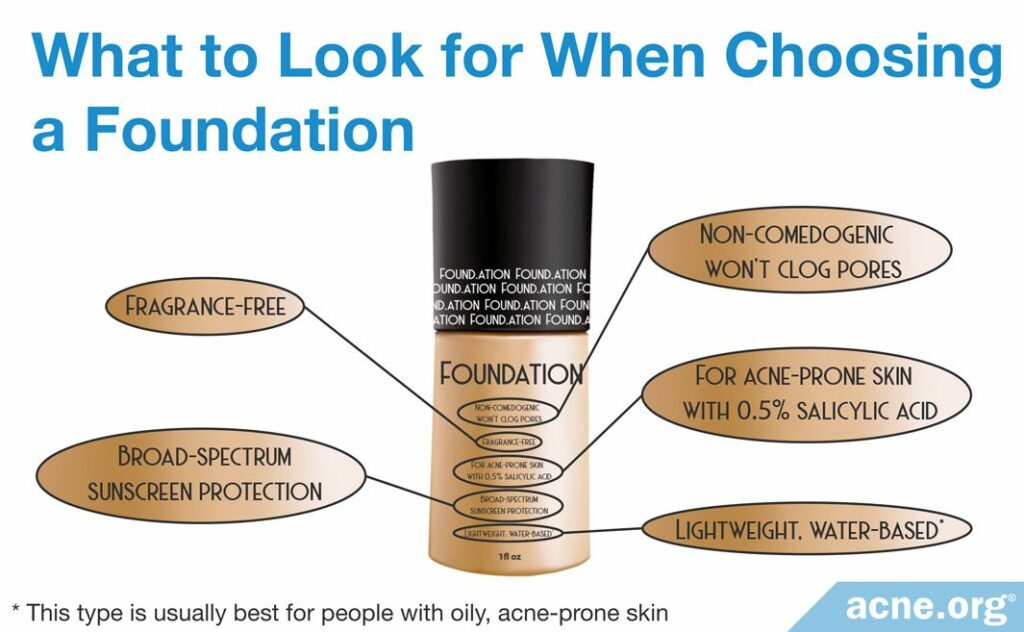
- Avoid pore-clogging ingredients: Take a look at the list of ingredients before buying any foundation. Avoid foundations that contain comedogenic (pore-clogging) ingredients. The table below provides a complete list of common comedogenic ingredients.
- Look for a fragrance-free product: Fragrances, found in many foundations, are the ingredient most likely to cause allergies. Even if you are not allergic to fragrances, they may irritate your skin and thus increase acne. It is best to select a fragrance-free foundation.
- If possible, find a foundation that contains sunscreen: If you spend a lot of time in the sun, it is important to protect your skin from the sun’s rays. Look for a foundation containing broad-spectrum sunscreen. If you choose a foundation without sunscreen, you can use a separate sunscreen product, but when it comes to acne-prone skin, the fewer products you need to put on your face, the better.
- If possible, choose a foundation made specifically for acne: Some manufacturers produce foundations for acne-prone skin by adding salicylic acid, which is somewhat effective against acne. The concentration of salicylic acid in makeup is quite low, so it is unlikely to dramatically improve acne. Still, it may be a good idea to choose a foundation with this ingredient if you can find it.
- Look for the right foundation for your skin type: If your skin is oily, a lightweight, water-based foundation with a matte finish may be the best option.
List of Common Comedogenic (Pore-clogging) Ingredients in Makeup
Many scientific studies have looked at how likely various ingredients are to cause comedones (clogged pores).4 We have thoroughly reviewed this research and compiled two lists:
- Definitely avoid: These are ingredients that people with acne-prone skin should definitely avoid, because a substantial amount of evidence shows that they are comedogenic.
- Consider avoiding: These are ingredients that people with acne-prone skin may wish to consider avoiding, because some evidence suggests that they might be comedogenic.
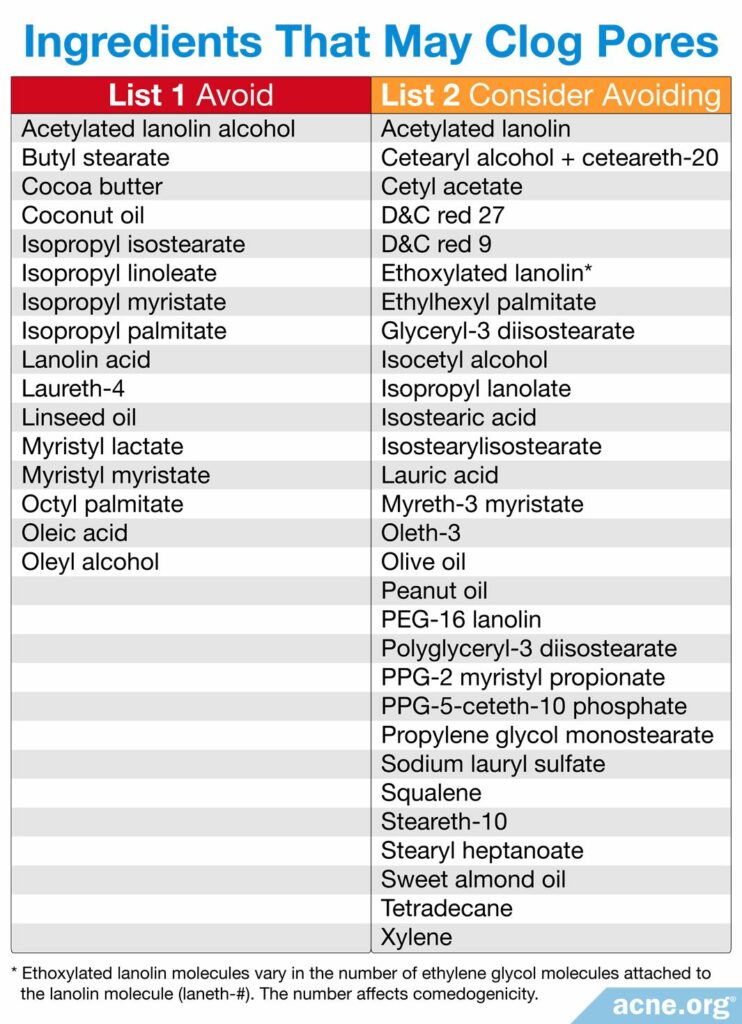
Tips for Using Foundation on Acne-prone Skin
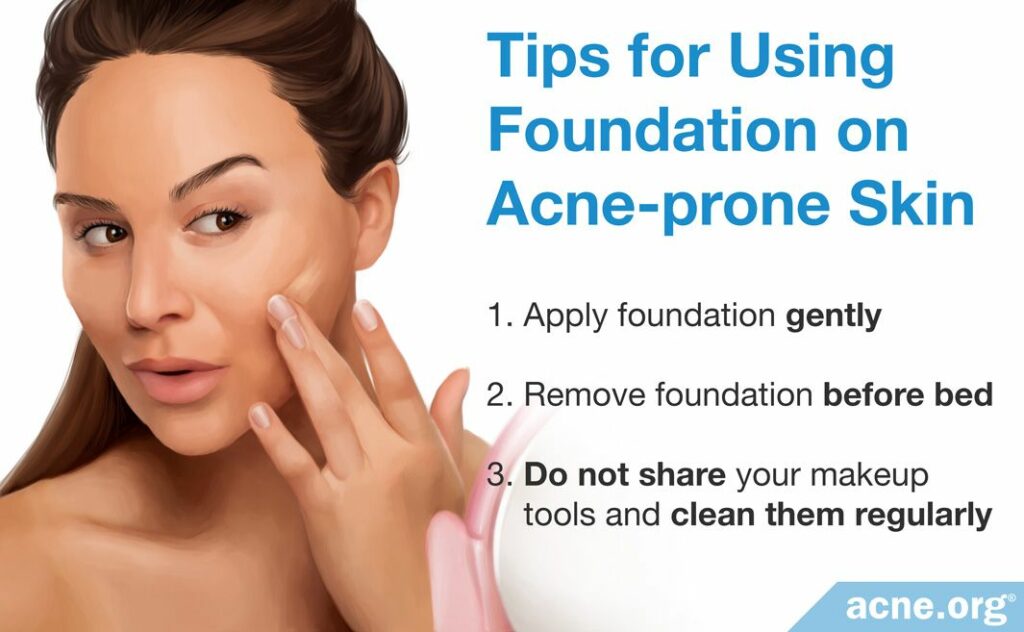
Whenever you apply foundation or any other cosmetics to acne-prone skin, it is very important to avoid irritating the skin. Scientists have shown that physical irritation of the skin can aggravate acne.6 In addition, always practice good hygiene to reduce the risk of skin infections. When you use foundation on acne-prone skin, keep these tips in mind:
- Apply foundation gently: Traditional makeup sponges can be irritating to the skin.7 A safer choice is to apply foundation with your fingertips or with the softest makeup brushes. Always apply makeup gently to avoid irritating the skin.
- Remove foundation before bed: The skin is more vulnerable at night, so it is good practice to remove all makeup, including foundation, before you go to bed. Remove foundation gently so as not to irritate the skin.
- Do not share your makeup tools and clean them regularly: Sharing makeup tools increases your chances of contracting a skin infection. Do not share your makeup brush or other tools with anyone. Using disposable tools or cleaning your tools regularly will prevent the growth of mold and bacteria.8-10
Foundation Ingredients: The Full Scoop
Foundation is a makeup product that achieves a smooth and even complexion by covering minor skin imperfections like large pores, dark spots, and small wrinkles. People with acne often use foundation to lessen the appearance of red and inflamed acne lesions as well. Consumers may also use foundation to give their skin a more matte or dewy finish.1,2
Originally, only professional makeup artists working on television used foundation. The first commercially available foundations were Max Factor’s Pancake and Pan Stick.3
A good foundation should be:
- Easy to apply
- Natural-looking
- Comfortable to wear
- Long-lasting on the face
- Safe for the skin and non-comedogenic1,2
Types of foundation
Today’s foundations come in a wide variety of forms, including liquids, gels, creams, solid creams, cakes, mousses, and sticks.1-3 The main types of foundations are:2
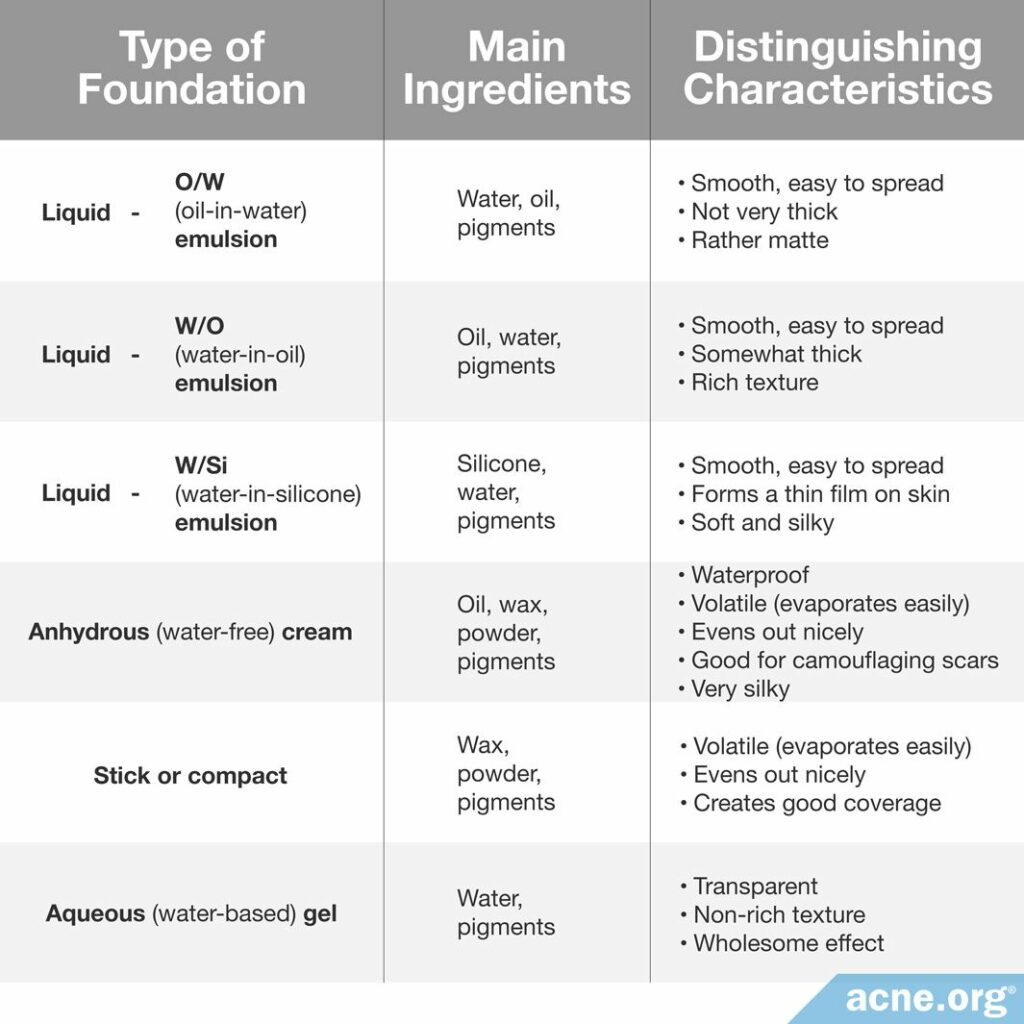
When it comes to liquid foundations, the main difference between the three types of emulsions is how much water and oil each of them contains.11
- An O/W foundation contains a large amount of water and a small amount of oil, and is recommended for people with oily skin.
- A W/O foundation contains a smaller amount of water and a larger amount of oil, and is ok for people with dry skin, so long a it does not contain comedogenic oils.
- A W/Si foundation contains a small amount of water and no oil, and is suitable for people with oily skin.1
It may be difficult to tell from the packaging whether a particular liquid foundation is O/W, W/O, or W/Si. However, the manufacturer may specify that the foundation is for normal, dry, or oily skin. Even so, the most important thing when choosing a foundation is to make sure that there are no comedogenic ingredients.
Foundation ingredients
Foundation ingredients vary widely depending on whether the foundation is a liquid, cream, solid, or gel. The table below shows the most common types of ingredients in foundation.1-3 Some of these ingredient types are marked with an asterisk (*) because they may be comedogenic or irritating. Before buying any foundation, always consult the list of ingredients and verify that none of them appear in the list of comedogenic ingredients at the beginning of this article.
In addition, steer clear of foundations with ingredients to which you are have allergies. If you are not sure whether you are allergic to a makeup product, you can perform a patch test. Place a small amount of product on an inconspicuous patch of skin and wait several hours to see whether you experience skin irritation or itching.
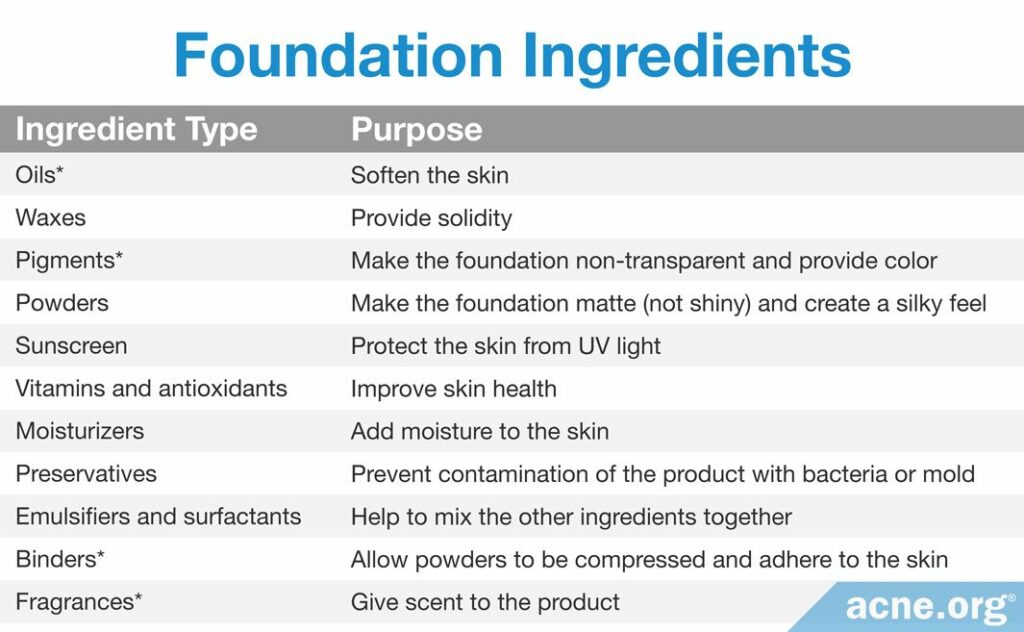
Salicylic acid in foundation
Some foundations contain salicylic acid, which is somewhat effective against acne. Over-the-counter products like makeup are legally only allowed to contain a small amount of salicylic acid, which is unlikely to cause a dramatic improvement in acne. Still, if you can find a foundation with this ingredient, it might be beneficial.
Unlike some other anti-acne active ingredients, salicylic acid will not make your skin more sensitive to the sun. Because salicylic acid can promote the replacement of dead skin cells with new cells, using a foundation with this ingredient may, over time, give your skin a slightly “fresher” look. However, keep in mind that a foundation without salicylic acid can be a good choice as well.
Sunscreen in foundation
If you spend a significant amount of time in the sun, it is important to protect your skin from the sun’s rays. Excessive sun exposure can cause sunburn, and in people with acne, it can also add to so-called post-inflammatory hyperpigmentation (darkening of acne lesions after they heal). Therefore, it is best to look for foundation that contains broad-spectrum sunscreen. This way, you will not need to wear a separate sunscreen in addition to foundation. When it comes to acne-prone skin, the fewer products you place on your skin and the less you need to touch the skin to apply them, the better.
Risk of skin infection from makeup tools
Several research studies have confirmed that using clean makeup tools is essential for preventing skin infections:

A study published in 2012 in the Journal of Scientific Research found that repeatedly using makeup sponges and brushes led to the tools becoming contaminated with bacteria and fungus. The authors of the study wrote, “From the present study it can be concluded that repetitive use of [makeup] tools…can cause serious skin infections.” The researchers recommended proper cleaning of used makeup tools to prevent catching a skin infection.8

Another study published in 2016 in the journal Health Promotion Perspectives showed that sharing makeup tools and makeup products increases the risk of infection with bacteria and fungus. The authors recommended that consumers avoid sharing makeup and makeup tools.9
A Master’s thesis published in 2016 at the University of Nevada looked at different commercial products for washing makeup tools. The author found that all commercially available cleaning products were effective at removing bacteria from dirty makeup tools.10
References
- Nguyen, S. H., Dang, T. P. & Maibach, H. I. (2009). Handbook of Cosmetic Science and Technology, 3rd Edition. Informa Healthcare 583 – 586. https://www.academia.edu/28676594/Barel_Paye_Maibach_-_Handbook_of_Cosmetic_Science_and_Technology
- Valet, B., Mayor, M., Fitoussi, F., Capellier, R., Dormoy, M. & Ginestar J. (2007). Colouring Agents in Decorative and other Cosmetics. In: Analytical Methods Analysis of Cosmetic Products, 1st Edition. Elsevier 145-148. https://kundoc.com/pdf-colouring-agents-in-cosmetic-products-excluding-hair-dyes-.html
- Riley, P. Decorative cosmetics. (2000). In: Poucher’s Perfumes, Cosmetics and Soaps, 10th Edition. Kluwer Academic Publishers. 166-178. http://priede.bf.lu.lv/grozs/AuguFiziologijas/Augu_resursu_biologija/gramatas/Perfumes Cosmetics Soaps.pdf
- Kligman, A. M. & Mills Jr., O. H. (1972) ‘Acne cosmetica’. Archives of Dermatology, 106, 843 – 850. https://www.ncbi.nlm.nih.gov/pubmed/4264346
- Katoulis A. C., Kakepis E. M., Kintziou H., Kakepis M. E. & Stavrianeas N. G. (1996). Comedogenicity of cosmetics: a review. Journal of the European Academy of Dermatology and Venereology, 7, 115-119. https://onlinelibrary.wiley.com/doi/abs/10.1111/j.1468-3083.1996.tb00606.x
- Mills, O. H. & Kligman, O. (1975). Acne mechanica, Archives of Dermatology, 111, 481-483. https://www.ncbi.nlm.nih.gov/pubmed/123732
- Adamowicz, M. S., Labonte, R. D. & Schienman, J. E. (2015). The Potential of Cosmetic Applicators as a Source of DNA for Forensic Analysis, Journal of Forensic Science, 60, 1001-1011. https://www.ncbi.nlm.nih.gov/pubmed/25783027
- Naz, S., Iqtedar, M., Ain, Q. & Aftab, K. (2012). Incidence of Human Skin Pathogens from Cosmetic Tools used in Beauty Saloons from Different Areas of Lahore, Pakistan. Journal of Scientific Research, 4 (2), 523-527. https://www.banglajol.info/index.php/JSR/article/view/9640
- Dadashi, L. & Dehghanzadeh, R. (2016). Investigating incidence of bacterial and fungal contamination in shared cosmetic kits available in the women beauty salons, Health Promotion Perspectives, 6(3), 159-163. https://www.ncbi.nlm.nih.gov/pmc/articles/PMC5002883/
- Ortiz, V., Effectiveness of commercially-available cosmetic cleaners on cosmetics and cosmetic brushes, Master Thesis, The Graduate College, The University of Nevada, Las Vegas, April 14, 2016. https://digitalscholarship.unlv.edu/cgi/viewcontent.cgi?article=3718&context=thesesdissertations
- Hollenberg, J. (2007). Surfactants in Liquid Foundation. In: Surfactants in Personal Care Products and Decorative Cosmetics, 3rd Edition. CRC Press, 243-250. https://www.routledge.com/Surfactants-in-Personal-Care-Products-and-Decorative-Cosmetics/Rhein-Schlossman-OLenick-Somasundaran/p/book/9781574445312
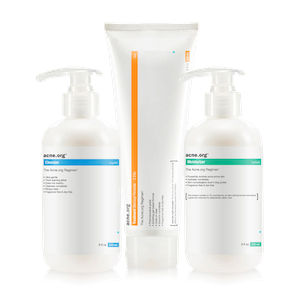 Acne.org Products
Acne.org Products